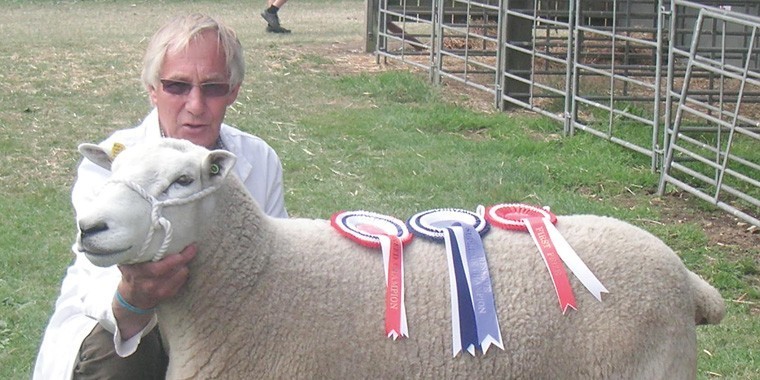To many the name Peter Corbett means nothing. But he was a figurehead of a movement that made a enormous contribution to the growth and development of the English sheep industry.
Peter Corbett was a Thirteenth century Shropshire knight, also known as “the Great Hunter,” who in 1281 was commissioned by Edward I to rid England of wolves. This task occupied Corbett and his teams of hunters for the next nine years. It wasn’t until Christmas 1290 that he was able to celebrate the demise of the last wolf in England.
In reality Corbett was the full stop at the end of a three centuries long chapter of persecution of the wolf. Perhaps that should be more of a colon, as occasional sightings endured in the north of the country for another couple of decades and wolves persisted in the wilds of Scotland until the late seventeenth century.
So what has this got to do with sheep? The wolf was the final top predator to be eliminated in England (the brown bear, 1,000 AD; and the Lynx 400 AD were both distant memories).
As a result, sheep flocks were able to flourish, free from the threat of predation, without the requirement to be fold sheep at night and maintain close shepherding during the day, sheep keeping became very much easier. Our European neighbours were not so lucky: a wide open eastern border made the elimination of wolves a virtual impossibility. Flocks remained small and closely guarded, leaving the way open for England and later the UK to become the sheep flock and wool producer of Europe, a position it still holds to a large extent today. Flock owners in many regions of southern and eastern Europe, even today, have to protect their charges against the threat of wolves and other large predators, often by using a range of livestock guard dogs (LGDs). The Pyrenean comes immediately to mind, but a host of different breeds of LGD were bred: the Mareema (Italy), Akbash (Turkey), Sarplaninac (Yugoslavia), Komodor (Hungary), Estrela (Portugal), Polish Tatra, Kangal (Turkey) – the list goes on. These dogs have been employed for centuries and are being increasingly used today, not just in Europe but across the world (we were able to focus on smaller and more agile herding dogs – hence the dominance of the Border Collie). The French managed at one time to eliminate wolves, but not until the 1930s. This was only a brief hiatus: in the early 1990s, a few wolves crossed the Alps back into France from Italy. The wild wolf population in France is now in excess of 430, an increase of 20% since 2017.
In spite of selective culling of problem wolves by the “wolf brigade,” documented wolf attacks in 2017 numbered more than 12,000, with €20 million being paid in compensation to French farmers. This is even though farmers are expected to prove and provide expert evidence, before compensation is paid, that wolves were responsible.
In Italy centuries of persecution of wolves reduced the population to about 100 by the 1960s: as a result hunting of wolves was banned in 1971, allowing the wolf population to increase to an estimated population of 2,000 in 2018. In Tuscany alone, sheep losses to wolves were estimated to be in the region of 500 last year. Both Italy and France have government funding available to sheep and goat producers, to finance protective measures, generally electric fencing or LGD’s.
So why does this matter to us? We don’t have large predators, or do we? We certainly have an increasing incidence of predation on sheep by a large predator that, in terms of its DNA, is approximately 98% wolf, i.e. the domestic dog. In addition we have a number of “environmental” organisations lobbying for the reintroduction into the UK ecosystem of a large ambush predator (the Eurasian lynx) and an even larger pursuit predator (the grey wolf). The argument is that they will help to redress the balance by predating on the ever increasing deer population of the UK. It does not, however, require a genius to work out that the sheep is a significantly softer target, for both ambush and pursuit predators, than the deer. The lynx is not just a “big pussy cat”: it is a very efficient, powerful 20 to 30 kilogram hunting machine that will quite readily take on and kill an adult sheep. There is plenty of evidence from Scandinavia and the rest of Europe to support this. The wolf does not need further comment.
How real is this threat? Who knows? With the ever increasing influence of the green lobby within government, nothing can be ruled out. The problem is that should the worst case scenario develop we currently have no defence mechanisms and I suspect there would be no compensation paid to producers. Electric fencing is an option, but only in areas where the potential is very low risk. Any possible reintroductions will, almost certainly, be focused on wild areas, areas with open hill and mountain grazing, impossible to protect with physical barriers.
The other line of defence and most frequently used in many European countries is the use of livestock guard dogs. But current legislation – in particular section two of the Animal Act 1971 – would make their deployment a very risky option for any sheep producer in the UK. If any reintroductions of top predators are permitted, sheep producers need to be in a position to deploy effective resources to protect their stock and livelihoods. If this requires a change in legislation this needs to be in place in advance of any reintroduction. Even without the reintroduction of major predators there is already a very strong argument – and getting stronger as rural police resources become increasingly stretched – in favour of a change in legislation to enable producers to deploy LGD’s to protect their flocks from the threat of worrying by 98% wolves, i.e. the domestic dog.




